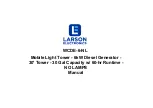
Chapter 4: Commissioning of the facility
SolarEdge Installation Guide - MAN-01-00060-2.6
27
2
Note the serial number on the label # of the inverter. This information is used in the portal
2
Note the serial number on the label # of the inverter. This information is used in the portal
SolarEdge supervision to identify this inverter and is needed for opening a new site in the monitoring portal.
Your energy conversion system SolarEdge is now operational.
Step 4, Reporting and Monitoring Data
installation
NOTE :
This step requires the connection of one of the communication options. Refer to
Chapter 6: Communication Setup on page 43.
This step requires the connection of one of the communication options. Refer to
Chapter 6: Communication Setup on page 43.
This step requires the connection of one of the communication options. Refer to
Chapter 6: Communication Setup on page 43.
The SolarEdge monitoring system
The SolarEdge Monitoring Portal provides access to SolarEdge site information, including updated information
displayed in a physical or logical layout. The Monitoring Portal is described in detail in
User Guide SolarEdge
displayed in a physical or logical layout. The Monitoring Portal is described in detail in
User Guide SolarEdge
Monitoring Portal,
available on the website at SolarEdge
http://www.solaredge.com/files/pdfs/solaredgemonitoring-portal-user-guide.pdf.
Monitoring Portal,
available on the website at SolarEdge
http://www.solaredge.com/files/pdfs/solaredgemonitoring-portal-user-guide.pdf.
Monitoring Portal,
available on the website at SolarEdge
http://www.solaredge.com/files/pdfs/solaredgemonitoring-portal-user-guide.pdf.
The SolarEdge Monitoring Portal can display the physical arrangements and logical system installed, as follows:
•
logical layout:
shows a diagram of the logic arrangement of the system components, for example inverters,
logical layout:
shows a diagram of the logic arrangement of the system components, for example inverters,
strings and modules and their electrical connections. This view allows you to view which modules are connected
to each string, which strings are connected to each inverter and so on.
•
Physical layout:
shows a diagram of the physical layout of the system components, for example inverters, strings
Physical layout:
shows a diagram of the physical layout of the system components, for example inverters, strings
and modules and their electrical connections. This view provides an overview of the current location of a computer
component.
The use of the portal, you can:
•
View the latest performance of specific components.
•
Find underperforming components, such as modules, comparing their performance to that of
other components of the same type.
•
Locate the location of the alert components using the physical layout.
•
See how components are connected to each other.
•
Pairing remote power optimizers
To view the logical layout, insert the serial number of the inverter in the new site created in the application. When
communication between the inverter and the control server is established, the logic arrangement will appear.
To display the physical layout, you have to draw the map of the locations of installed power optimizers. To generate a
physical map, use the iPhone application Site Mapper or perform a mapping model, which must be completed with
removable stickers (see
Provide information about the installation
below).
removable stickers (see
Provide information about the installation
below).
removable stickers (see
Provide information about the installation
below).
The logical and physical mapping can be used to solve a problem using the SolarEdge Monitoring Portal.
If you have not sent the physical mapping of the installed power optimizers SolarEdge Monitoring Portal will show the logical
layout indicating which power optimizers are connected to which inverter, but will not show strings or the physical location of
optimizers power.
















































